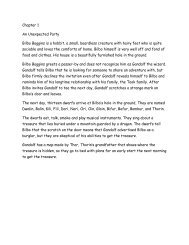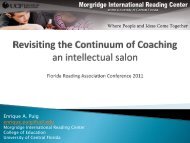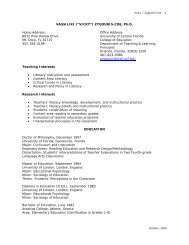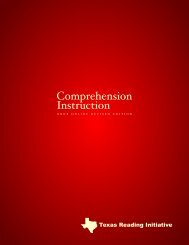FLaRE Professional Paper: Motivation - College of Education ...
FLaRE Professional Paper: Motivation - College of Education ...
FLaRE Professional Paper: Motivation - College of Education ...
You also want an ePaper? Increase the reach of your titles
YUMPU automatically turns print PDFs into web optimized ePapers that Google loves.
Neuman & Celano, 2004). Several studies have reported<br />
that many students retrieve books for independent reading<br />
from the school or classroom library (Fleener, Morrison,<br />
Linek, & Rasinski, 1997; Krashen, 1993; Lamme, 1976;<br />
Worthy, Moorman, & Turner, 1999). Perhaps those<br />
students benefiting the most from retrieving books from<br />
classroom and school libraries are those who have little or<br />
no access to books. In spite <strong>of</strong> this research, funding for<br />
classroom, school, and town libraries has seriously<br />
declined over the past decade. According to a recent<br />
position statement by the International Reading<br />
Association, “We must reverse this trend because children<br />
who have access to books are more likely to read for<br />
enjoyment, and thus increase their reading skills and their<br />
desire to read to learn” (IRA, 2000, p.1). Educators need to<br />
also pay attention to the types <strong>of</strong> reading materials in the<br />
classroom library, ensuring that the materials not only<br />
address a range <strong>of</strong> reading levels and interests, but that<br />
they appeal to both boys and girls. According to Knowles<br />
and Smith (2005), “Classroom libraries, librarians,<br />
summer reading, and required course reading lists do not<br />
reflect the kinds <strong>of</strong> books that boys enjoy most” (p. xi)<br />
which tend to be factual, humorous, with lots <strong>of</strong> visual<br />
stimulation and support for the text. Including a wide<br />
variety <strong>of</strong> types <strong>of</strong> texts, from newspapers and trade<br />
paperbacks to “classics” to comic books is essential.<br />
Allowing students frequent access to these materials and<br />
giving them the opportunity to take these materials home<br />
is essential, as many students are not able to borrow books<br />
from the public library, for a variety <strong>of</strong> reasons.<br />
The Social/Emotional/Intellectual Environment<br />
In addition to having access to texts in the classroom,<br />
students at all grade levels need time to read, both in and<br />
outside <strong>of</strong> school. Practice makes perfect, as the popular<br />
proverb reminds us. Allington (2001) stated that the act <strong>of</strong><br />
reading is powerful in developing readers who read with<br />
accuracy, fluency, and comprehension. Anderson, Wilson,<br />
and Fielding (1988) found that students who did not read<br />
during their free time outside <strong>of</strong> school ultimately lost<br />
academic ground, even those who were not originally<br />
labeled as remedial readers. Furthermore, the National<br />
Assessment <strong>of</strong> <strong>Education</strong>al Progress (NAEP) discovered<br />
hundreds <strong>of</strong> correlational studies which revealed<br />
successful readers simply read more in and out <strong>of</strong> school<br />
(Donahue, Finnegan, Lutkus, Allen, & Campbell, 2001).<br />
In commenting about the “remarkably consistent” link<br />
between free reading and literacy development, Krashen<br />
(1993) noted that “Nearly every study that has examined<br />
this relationship has found a correlation, and it is present<br />
even when different tests, different methods <strong>of</strong> probing<br />
reading habits, and different definitions <strong>of</strong> free reading are<br />
used” (p. 7). Time to read must be allocated in the daily<br />
classroom schedule to show that it is a valued activity and<br />
to give students a chance that they might not take outside<br />
<strong>of</strong> school to discover books that they enjoy.<br />
Students need to be allowed to make choices about some<br />
<strong>of</strong> the materials that they read, especially for independent<br />
(free) reading, and for literature discussion groups. Choice<br />
about what books to read, and how to demonstrate an<br />
understanding <strong>of</strong> the book is critically important. Teachers<br />
must resist the temptation to control students’ choices. For<br />
example, the growing practice <strong>of</strong> allowing students to<br />
borrow from the library and read only certain levels or<br />
types <strong>of</strong> books (i.e., a book that they can take a<br />
computerized test on) is a dangerous one and likely to<br />
mitigate against motivation to read. At the same time,<br />
teachers need to help students learn to make good choices,<br />
by teaching them how to select a book that they can read<br />
successfully (e.g., Ohlhausen & Jepsen, 1992; Routman,<br />
2003). Teachers need to know their individual learners’<br />
interests and hobbies, and know the field <strong>of</strong> children’s<br />
literature so that they can help to match students with<br />
books that will be interesting and satisfying.<br />
Teachers need to model, through daily interactive read<br />
alouds the value <strong>of</strong> reading. In order to influence<br />
students’ own reading, Routman (2003) advocates for<br />
teachers to make their “reading lives explicit” (p. 25).<br />
She encourages teachers to (pp. 23-37):<br />
• Let students know what you are reading and<br />
what you read next;<br />
• Share your passion for reading;<br />
• Discuss the importance and pleasure <strong>of</strong> having a<br />
personal library;<br />
• Talk about favorite authors and favorite books;<br />
• Talk about how book clubs work;<br />
• Explain how you choose books to read;<br />
• Read a variety <strong>of</strong> genres;<br />
• Maintain a reading record;<br />
• Show your students how you read; and<br />
• Demonstrate your pleasure in reading.<br />
Students need opportunities to interact with peers, to<br />
communicate about books and their responses to books<br />
and the chance to collaborate with them on assignments.<br />
Cole conducted a study in an attempt to understand what<br />
motivated several second-graders to read (2002/2003).<br />
She found each student was motivated to read for<br />
different reasons and obtained a unique literacy<br />
personality. Most <strong>of</strong> the students in her study were<br />
motivated to read due to one or more social components<br />
<strong>of</strong> the classroom such as class discussions and acting out<br />
stories with peers. As a result <strong>of</strong> her findings, Cole<br />
suggested that teachers provide flexible literacy<br />
activities including those that allow for social<br />
interactions. Cole stated, “While some students learn<br />
efficiently on their own, many children need the support<br />
<strong>of</strong> peers and talk to learn and achieve” (p. 335). In<br />
addition, creating opportunities for productive social<br />
interactions increases students’ effort and persistence,







